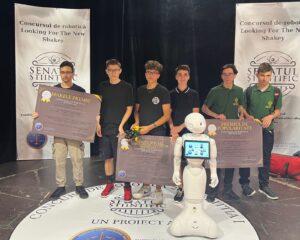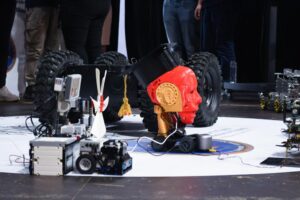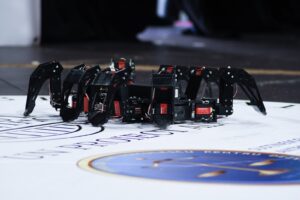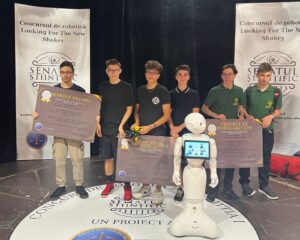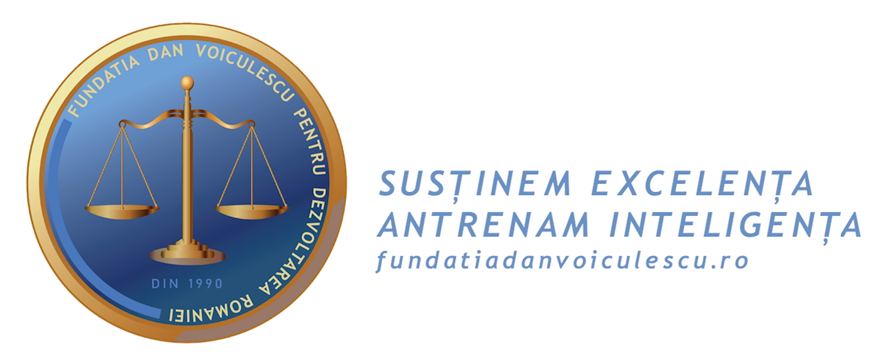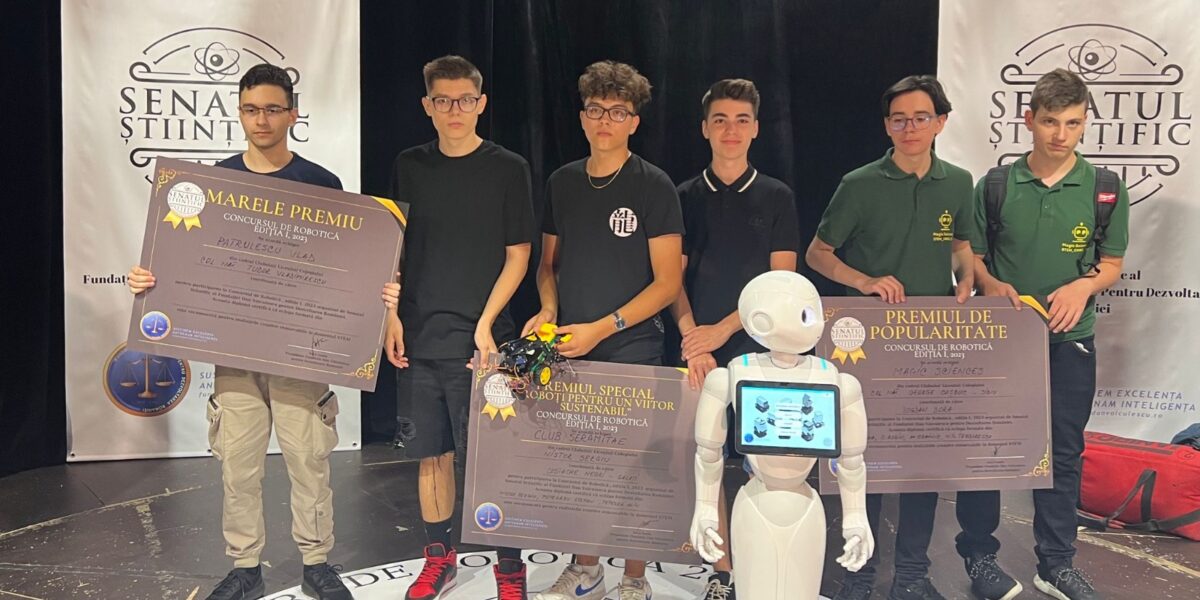The first edition of the robotics competition "Looking for the New Shakey", organised by the Scientific Senate of the Dan Voiculescu Foundation for the Development of Romania, announced its winners at an event organised in the Centenary Hall of the Metropolis Theatre in Bucharest.
Teams from leading robotics clubs from all over the country took part in the competition, which aimed to encourage innovation in this up-and-coming field.
Young innovators presented robots with different uses that, in the future, could effectively replace a multitude of activities for which human resources are currently used. Among the finalists was the AutoVortex CSU ASE Romania team, one of the most awarded robotics teams in Romania and abroad. Just this year the team won awards at the World Robotics Championship in the USA - AutoVortex succeeded in receiving the "Alliance Award Finalist" in the Edison division final and the "Control Award" for advanced Java programming of the competition robot. In February 2023, AutoVortex won 1st place at the International Robotics Championship in South Korea. In July 2022, the team won 1st place at the International Robotics Championship in Utah, USA in July 2022, and in 2021, in Chicago, USA, they won 1st place at an International Robotics Championship.
The final of the competition showcased robots that can collect and sort waste from various surfaces, walk through water or rough terrain, or do construction or disaster safety work.
Who are the big winners
The award event was hosted by Pepper, Romania's first humanoid social robot, developed to communicate and interact with humans. Pepper has multiple functions, it can store information about those it interacts with, which it then identifies using facial scanning.
Pepper announced the decision of the competition's jury, which had the difficult task of selecting the best of the nine projects that made it to the final.
The grand prize of the "Looking for the New Shakey" robotics competition was won by young innovator Vlad Alexandru Pătrulescu who presented a remote-controlled robot in the shape of a spider — the Lens V 2 Robot. The Lens V 2 robot has the ability to move easily over rough surfaces and access locations that may be unsafe for people at risk. The Lens V2 robot could be used in reconnaissance and identification missions in toxic environments where humans would not have access. "The robot is just one of my projects that I have been working on for 2 years. It's actually a multi-purpose platform that could have different applications. I've been passionate about this field since 3rd grade and I'm glad that my robot was so appreciated in this competition", said Vlad Pătrulescu., a declarat Vlad Pătrulescu.
The grand prize is financial support for the next robotics project to be developed by the winner of the competition.
The prize for sustainability was won by the Seramitae Robotics High School Club of the "Costache Negri" National College, Galati, with a robot that can collect waste from various surfaces and could replace the work of cleaning staff on pavements and in parks. The team presented a miniature model, but the innovators promise to develop it in the future.
The Popularity Award was won by the Magic Sciences team from the "George Coșbuc" National College in Cluj with a platform for monitoring and warning of pollution and weather threats. The ambitious project consists of a terminal that could process information from multiple systems.
Robots of the present, indispensable helpers of the future
In fact, all the finalist projects showcased the talents of young Romanian innovators and robotics teams that have already won international awards. This is why we believe that all 9 finalist projects deserve to be popularized:
TEAM MEMBERS - Nistor Sergiu, Poterasu Stefan, Pepelea Alin
Team captain - Nistor Sergiu
Town halls all over the country would be delighted to have the Seramiclean robot on the sidewalks that will keep clean and help protect the environment in any public space. Developed and mass produced this robot could do operations that now consume significant human and financial resources.
What the Seramiclean robot can do
It works autonomously and will be able to selectively collect waste from cities, distinguishing between plastic, metal and paper. In fixed mode, the Seramiclean robot will only move to a specific perimeter to empty waste bins in public spaces, and in charging mode, it will return to its base to charge its batteries. Completely safe on the move, the robot is equipped with motion sensors that allow it to avoid people or obstacles.
TEAM MEMBERS - Bora Bogdan; Oara Robin; Crainic Mihai; Teodorescu Gabriel Nicolae
Team captain - Gabriel Nicolae Teodorescu
Bucharest and other cities in the country currently have a high level of pollution, and the ability to quickly detect safety violations could help stop toxic sources. The Magic Science team presented an experimental device for monitoring air quality and collecting meteorological data.
What the air monitoring device can do
Any excesses of the safe levels of pollutants present in the air at the time of measurement are recorded by the device. The device can have both industrial applications for production sites emitting greenhouse gases and civil applications for monitoring air quality inside metropolitan areas.
TEAM MEMBERS - Morariu Timotei, Bâlc Emanuel, Crenganiș Mihai
Team captain - Morariu Timotei
Whether you are an amateur or a professional field tennis player, you have found that retrieving balls is a time-consuming and physically demanding operation. The Cyber Tech team at the Faculty of Engineering in Sibiu thought that this could be done quickly and efficiently by a robot so they invented a machine that can quickly and efficiently identify and retrieve field tennis balls.
How the ball retrieval robot works
Autonomous tennis ball retrieval robot, a robot with practical utility for any tennis court and athletes training. The robot has a mass of 20 kg, a differential locomotion system and can collect several balls simultaneously without requiring precise positioning at the ball. The collection basket has a capacity of 70 balls. To detect balls on the ground the robot is equipped with a Pixi 2 camera that performs colour-based filtering of information from the environment. When detecting the ball (green colour) the robot will move for collection. From now on, tennis training can be much more intense with such a reliable helper.
Throughout history many people have lost their lives being sent on various dangerous prospecting and rescue missions. But progress has allowed the use of robots in some cases. One such robot was presented to the competition by Vlad Alexandru Pătrulescu, a student at Tudor Vladimirescu National High School.
How the Lens V2 Robot works
The Lens V2 robot, a reliable aid for occupational safety and protection departments, has practical applications in the construction, mining and energy industries. It is a robot equipped with a modular measuring system that can navigate any type of rough terrain. It has an operating time of 3 hours and a transmission distance of 3 km outdoors. The image sensor has a high sensitivity to all types of light and can take images in the dark without a light source. Lens V2 is a robot ready to save lives or explore dangerous and risky environments at any time.
TEAM MEMBERS - Marghidan Alexandra Ioana, Georgescu Vlad
Team captain - Marghidan Alexandra Ioana
Another robot presented by young innovator Vlad Georgescu is a multi-purpose machine that can carry 2300 kilograms over land and water. It can be used to assist in agricultural work, transport products or people, ensure security through patrolling, perimeter scanning, warning, fire intervention or fire-fighting.
How the multifunctional robot works
Whether we're looking at our future rescuer or our future courier, this robot can move through water as well as on land and can be controlled via the internet from anywhere on the planet. The robot will be a real help in various industries or everyday situations.
TEAM MEMBERS - Gheorghică Istrate David
What if there was a robot that could give us clothing advice and, the very same robot could help blind people to identify more easily various elements and people in the environment. The Informatics for the Future Association has presented such a robot, called Cuza, which also has translator functions.
How the Cuza robot works
The Cuza robot could be the future translator, with a function to optimise conversation between people who do not share a common language. The robot also has a built-in Chat-GPT function and can provide information on any topic. The clothing recognition function can make Cuza the future stlye advisor or help blind people to choose their outfits.
In a world where energy resources are almost depleted, more solutions for renewable energy production are needed. Damiel Tincescu and Rucareanu Cosmin's project is an energy production station combining two renewable resources.
How the energy station works
To produce as much energy as possible, the station combines solar and wind power. The production capacity is 0.5 Wh for both solar and wind. The station, with its low production costs (around €300), aims to provide electricity for every household, making it the 'Energy Solution for Tomorrow'.
TEAM MEMBERS - Ene Cosmina, Muncelean Razvan, Hantascu Adrian, Ilie Scheferis Diana, Dragoi Laura, David Ioan, Dumitrescu Sasha, Costea Maria, Stanescu Serban, Vasile Briana, Biholar Vlad, Radu Andreea, Muntean Nicodim, Panea Ionut Valentin
Team captain - Craciunescu Stefan
The famous AutoVortex team, already winners of international awards, came with the Shakey robot, named after the first humanoid robot created by man
How the Shakey robot works
The Shakey robot is a robot with industrial applications. It can be used in a variety of industries and is capable of moving and fitting various objects with great precision. Shakey - Shakey responds to voice commands and can perform various tasks.
TEAM MEMBERS - Malinas Alisa Maria, Moga Sergiu Mihai, Florian Rares, Boroica Gabriel Vasile, Moga Antonia Iasmina, Fort Alexandra Maria, Steiu Alessandro Andrei, Malinas Andrei Ionut, Mocian Adrian
Team captain - Moga Antonia Iasmina
Another robot present in the competition was presented by the team of Petru Maior High School from Gherla. It is an innovation that will be able to replace a whole range of human activities in construction and beyond.
How the manipulating robot works
The fastest autonomous robot capable of moving objects with great precision and avoiding obstacles. It can have various industrial applications in areas such as construction, packaging and manufacturing.

